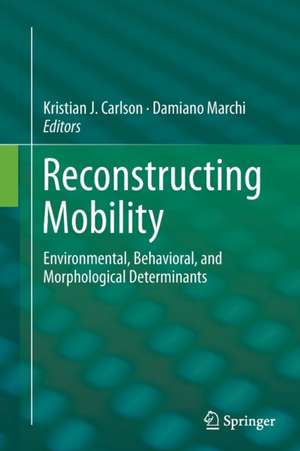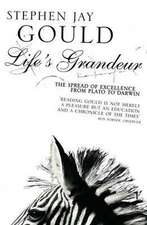Reconstructing Mobility: Environmental, Behavioral, and Morphological Determinants
Editat de Kristian J. Carlson, Damiano Marchien Limba Engleză Paperback – 19 sep 2016
| Toate formatele și edițiile | Preț | Express |
|---|---|---|
| Paperback (1) | 945.14 lei 6-8 săpt. | |
| Springer Us – 19 sep 2016 | 945.14 lei 6-8 săpt. | |
| Hardback (1) | 951.14 lei 6-8 săpt. | |
| Springer Us – 5 aug 2014 | 951.14 lei 6-8 săpt. |
Preț: 945.14 lei
Preț vechi: 1152.61 lei
-18% Nou
Puncte Express: 1418
Preț estimativ în valută:
180.85€ • 189.36$ • 150.00£
180.85€ • 189.36$ • 150.00£
Carte tipărită la comandă
Livrare economică 10-24 aprilie
Preluare comenzi: 021 569.72.76
Specificații
ISBN-13: 9781489979636
ISBN-10: 1489979638
Pagini: 295
Ilustrații: X, 295 p. 54 illus., 11 illus. in color.
Dimensiuni: 155 x 235 x 17 mm
Greutate: 0.44 kg
Ediția:Softcover reprint of the original 1st ed. 2014
Editura: Springer Us
Colecția Springer
Locul publicării:New York, NY, United States
ISBN-10: 1489979638
Pagini: 295
Ilustrații: X, 295 p. 54 illus., 11 illus. in color.
Dimensiuni: 155 x 235 x 17 mm
Greutate: 0.44 kg
Ediția:Softcover reprint of the original 1st ed. 2014
Editura: Springer Us
Colecția Springer
Locul publicării:New York, NY, United States
Cuprins
Chapter 1: Introduction: Towards Refining the Concept of Mobility.- Chapter 2: Long Bone Structural Analyses and the Reconstruction of Past Mobility: A Historical Review.- Chapter 3: Bipedalism and Musculoskeletal Stress Markers: Variation and What it reveals About Adaptation, Environmental Stress, and Reconstructing Activity Patterns.- Chapter 4: Does the Distribution and Variation in Cortical Bone along Lower Limb Diaphyses Reflect Selection for Locomotor Economy?.- Chapter 5: Human Variation in the Periosteal Geometry of the Lower Limb: Signatures of Behaviour among Human Holocene Populations.- Chapter 6: The Importance of Considering Fibular Robusticity when Inferring the Mobility Patterns of Past Populations.- Chapter 7: The Relationship between Femur Shape and Terrestrial Mobility Patterns.- Chapter 8: Activity, Body Shape, and Cross-sectional Geometry of the Femur and Tibia.- Chapter 9: Variation in Mobility and Anatomical Responses in the Late Pleistocene.- Chapter 10: Femoral Diaphyseal Shape and Mobility: An Ontogenetic Perspective.- Chapter 11: The Balance between Burden Carrying, Variable Terrain and Thermoregulatory Pressures in Assessing Morphological Variation.- Chapter 12: Territory Size in Canis lupus: Implications for Neandertal Mobility.- Chapter 13: The Effects of Terrain on Long Bone Robusticity and Cross-sectional Shape in Lower Limb Bones of Bovids, Neandertals, and Upper Paleolithic Modern Humans.- Chapter 14: Linearity in the Real World – An Experimental Assessment of Non-linearity in Terrestrial Locomotion.- Chapter
15 Femoral Mechanics, Mobility, and Finite Element Analysis.-
15 Femoral Mechanics, Mobility, and Finite Element Analysis.-
15 Femoral Mechanics, Mobility, and Finite Element Analysis.-
15 Femoral Mechanics, Mobility, and Finite Element Analysis.-
Notă biografică
Kristian Carlson received his PhD from Indiana University, Bloomington (USA) in 2002. Following this, he spent three years as a postdoctoral associate in the Department of Anatomical Sciences at Stony Brook University, NY (USA), and one year in a postdoctoral position in the Anthropologisches Institute and Museum at the University of Zürich (Switzerland). He was an Assistant Professor of Anatomy at the New York College of Osteopathic Medicine (USA) for two years before joining the Institute for Human Evolution (IHE) at the University of the Witwatersrand (South Africa) in 2009 as a Senior Researcher. His research interests include modelling form-function relationships in limb bones of primates, both extinct and extant. He utilizes a variety of approaches to tackle questions about the impact that behaviours have on skeletal form. These include experimental assessments of primate locomotion (i.e., kinematics and kinetics), focusing on transverse forces and the behaviours that accentuate them (e.g., turning); traditional comparative studies of ape limb bone cross-sectional properties, including leading analyses of habituated chimpanzee skeletons; and mouse model research aimed at testing the explicit predictions constructed from his work with primates. Ultimately the supported predictions from extant-based models are applicable to extinct primates, including hominins, in order to infer the nature of their behavioral repertoires, particularly the emphasis on arboreal locomotion in their evolutionary history.
Damiano Marchi received his PhD from the University of Pisa, Italy in 2004. From 2004 to 2010 he was Visiting Assistant Professor at Duke University, USA, teaching and conducting research on human and living primate locomotory postcranial functional morphology. From 2011 to 2012 he was a post-doctoral fellow at the Institute for Human Evolution, University of the Witwatersrand, South Africa. Since 2012 he is Lecturer of Anthropology at the University of Pisa, Italy and Honorary Research Fellow at the Evolutionary Studies Institute at the University of the Witwatersrand. His research focuses on the study of functional morphology and biomechanics of extant human and non-human primates. The results obtained by the study of extant primates are used to create models that can be applied: 1. to extinct hominins to make inferences on their locomotor behavior; 2. to Late Pleistocene/Holocene human populations to make inferences on their mobility and subsistence economy.
Damiano Marchi received his PhD from the University of Pisa, Italy in 2004. From 2004 to 2010 he was Visiting Assistant Professor at Duke University, USA, teaching and conducting research on human and living primate locomotory postcranial functional morphology. From 2011 to 2012 he was a post-doctoral fellow at the Institute for Human Evolution, University of the Witwatersrand, South Africa. Since 2012 he is Lecturer of Anthropology at the University of Pisa, Italy and Honorary Research Fellow at the Evolutionary Studies Institute at the University of the Witwatersrand. His research focuses on the study of functional morphology and biomechanics of extant human and non-human primates. The results obtained by the study of extant primates are used to create models that can be applied: 1. to extinct hominins to make inferences on their locomotor behavior; 2. to Late Pleistocene/Holocene human populations to make inferences on their mobility and subsistence economy.
Textul de pe ultima copertă
For decades, scientists have relied on the concept of mobility in describing lifeways of past and present human populations. However, studies of mobility tend to focus on one aspect of the many factors that define and contribute to it. It is the position of the scientists contributing to this book that mobility needs not be a narrowly defined concept (e.g., distance travelled), but rather should embrace a variety of factors.
Reconstructing Mobility assembles a collection of experts to provide a current account of different approaches in the study of mobility, including traditional, comparative and experimental approaches. The work presented here strives to tease apart environmental effects that transcend traditional categories (e.g., coastal versus inland, mountainous versus level, arboreal versus terrestrial). Since the environment undoubtedly impacts mobility of a wide variety of animals, insights into human mobility can be improved by extending investigations to comparable environmental influences on mobility in other animals in general. Moreover, the book aims to stimulate new theoretical perspectives that adopt a holistic view of the interaction between intrinsic (i.e. skeletal) and extrinsic (i.e. environmental) factors influencing differential expression of mobility. Such an integrative approach, when coupled with a new emphasis on mobility as types of activities rather than activity levels, offers fresh, insightful perspectives on mobility and how it might affect the musculoskeletal system.
In pursuing these aims, the editors have assembled contributions from a diverse collection of researchers. In each chapter, contributors explicitly define the concept of mobility as it relates to their particular research questions. Exciting results from non-primate animal models and experimental studies, as well as more traditional approaches to studies of human mobility, are featured. We believe the breadth of this volume will foster a synergy between several different approaches that ultimately will help advance knowledge about the role of mobility in human evolution.
Reconstructing Mobility assembles a collection of experts to provide a current account of different approaches in the study of mobility, including traditional, comparative and experimental approaches. The work presented here strives to tease apart environmental effects that transcend traditional categories (e.g., coastal versus inland, mountainous versus level, arboreal versus terrestrial). Since the environment undoubtedly impacts mobility of a wide variety of animals, insights into human mobility can be improved by extending investigations to comparable environmental influences on mobility in other animals in general. Moreover, the book aims to stimulate new theoretical perspectives that adopt a holistic view of the interaction between intrinsic (i.e. skeletal) and extrinsic (i.e. environmental) factors influencing differential expression of mobility. Such an integrative approach, when coupled with a new emphasis on mobility as types of activities rather than activity levels, offers fresh, insightful perspectives on mobility and how it might affect the musculoskeletal system.
In pursuing these aims, the editors have assembled contributions from a diverse collection of researchers. In each chapter, contributors explicitly define the concept of mobility as it relates to their particular research questions. Exciting results from non-primate animal models and experimental studies, as well as more traditional approaches to studies of human mobility, are featured. We believe the breadth of this volume will foster a synergy between several different approaches that ultimately will help advance knowledge about the role of mobility in human evolution.
Caracteristici
Presents a comprehensive overview of the different approaches used to study early human mobility
Puts forward a new, holistic approach to mobility that synthesizes intrinsic (i.e. skeletal) and extrinsic (i.e. environmental) factors
Investigates the structural expression of mobility in general rather than just in specific populations
Includes supplementary material: sn.pub/extras
Puts forward a new, holistic approach to mobility that synthesizes intrinsic (i.e. skeletal) and extrinsic (i.e. environmental) factors
Investigates the structural expression of mobility in general rather than just in specific populations
Includes supplementary material: sn.pub/extras













